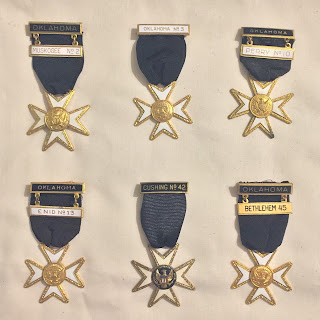When I was a
young Grand Commandery officer progressing through the grand line, I set out to
write the history of Templary in Oklahoma in 2012. That volume was completed
and published as Knights on the Prairie:
A History of Templary in Oklahoma. In May of 2012, I was sent to Kansas by
my employer and made a stop at an antique store in Blackwell, Oklahoma. It was
there that I purchased a Malta jewel and sword case from a defunct Oklahoma Commandery
of Knights Templar. That set into motion my desire to collect the memorabilia of
the Order, some of which is displayed here.
Malta Jewels
In American Freemasonry, the Order of the Temple is preceded by the Order of Malta. During the initiation ceremony of the Order of Malta, candidates receive the Order of Malta jewel. In many jurisdictions, bars are attached to the ribbon of the jewel which identifies the state and local commandery the Sir Knight is from.
Templar Regalia
Sword
When a Sir
Knight is first invested with his sword during the Order of the Temple, he is
told the following: In the hand of a Valiant and Magnanimous Knight of the
Temple, it is endowed with three excellent qualities: its hilt with Justice
impartial, its blade with Fortitude undaunted, and its point with Mercy
unrestrained.
The color of a Templar sword is used to identify rank: silver is for Sir Knights and gold is for Past Commanders. This sword belonged to Bert D. Ashbrook (1868-1935), who was knighted in Emmanuel Commandery No. 23 and later affiliated with Ascension Commandery No. 4. Ashbrook served as Grand Commander in 1927-1928.
Sword Cases
During the
height of fraternalism the major “regalia houses” offered leather sword cases
for fraternal swords. They came in three
basic varieties: plain with a small
brass name plaque, plain with painted name, and tooled leather with painted
name and cross emblem.
Sword Belt
Early
Templary in the Twin Territories featured a variety of regalia for the Order. The
1862 uniform regulations of the Grand Encampment called for a red leather sword
belt. Some commanderies even had belt plates produced that identified the
wearer’s commandery. This belt plate for Oklahoma Commandery No. 2 pre-dates
the 1911 merger of the Grand Commanderies of Indian Territory and Oklahoma. When
the two grand commanderies merged, Oklahoma Commandery was given the number “3”
owing to its date of dispensation being later than that of Muskogee Commandery.
Uniform
In 1859 the
Grand Encampment of Knights Templar of the United States first standardized the
regalia of the Order. This was followed by an 1862 revision which adopted the frockcoat,
seen above. The uniform was similar in style to the Model-1841 Undress
Frockcoat of the United States Army. This uniform would serve the Sir Knights
of the United States in some form for over 140 years. It was phased out of
service in Oklahoma beginning in 1948.
This
particular uniform belonged to Sir Knight Reid K. McKim (1896-1975) of Oklahoma
Commandery No. 3. McKim became a Freemason in 1923 at Oklahoma City Lodge No.
36. A veteran of the First World War, McKim served as an Oklahoma City Police
Officer in 1928.
Drill Badges and Bars
In 1921, the
Grand Commandery Knights Templar of Oklahoma introduced competitive field
drills. Teams from across the state would compete annually for the privilege to
compete at the national level. At the 38th Triennial Conclave of the Grand
Encampment in 1931, Gethsemane Commandery No. 25 of Okmulgee took Third Place
in the field drill competition. Lawton Commandery No. 18 would also earn
national honors in 1940 by taking Fourth Place in field drills.
Past Commander Jewels
The
presiding officer of a Commandery of Knights Templar is known as the Eminent
Commander. Once a Sir Knight has vacated that office, he earns the title of
Past Commander. To commemorate this service, a Past Commander jewel exists.
The jewel on
the left is a style which was presented by Oklahoma Commandery No. 3 and
Bethlehem Commandery No. 45 beginning in the 1920s. This particular jewel
belonged Richard E. Swan (1909-2000), the son of well-known Oklahoma Mason
Leslie H. Swan.
The jewel on
the right was presented to William E. Crowe (1893-1983) by Enid Commandery No.
13 for serving as Eminent Commander in 1928. Crowe became Grand Commander in
1940.
Past Grand Commander Jewel
This Past Grand Commander jewel issued by the Grand Commandery of Indian Territory is identified by an engraved Indian and “TER” for territory. This jewel was presented to Daniel M. Hailey (1841-1919) who served as Grand Commander in 1902-1903.
Grand Commandery Annual Conclave Souvenirs
To mark the occasion of the annual conclave of the Grand Commandery, souvenirs were often issued. These ranged from watch fobs, to jewels and ribbons. The pieces illustrated here include a watch fob from 1915 along with jewels from 1917, 1919, and 1921. The ribbons below include one from Indian Territory in 1902 along with others from 1931, 1937, 1938, 1950, and 1957.
Grand Encampment Triennial Conclave Souvenirs
Every three years, the Grand Encampment of Knights Templar meets in cities across the United States. It was once common for the grand commanderies that comprise the Grand Encampment to issue jewels for their delegations to wear and the Grand Encampment also issued jewels itself. Featured here are jewels from 1913, 1922, and 1946.
Of particular note are these 1910 jewels from the Grand Commandery of Indian Territory and Oklahoma. The two grand commanderies would merge in 1911 making these the last Indian Territory jewels produced for a Triennial.
In 1917, the
Grand Commandery Knights Templar of Oklahoma adopted a Coat-of-Arms that
included the Templar emblems of the Red Cross, Templar Cross, and Maltese
Cross. The Coat-of-Arms appeared on all stationery and proceedings of the Grand
Commandery then, as it does today. The Coat-of-Arms was even made into two
jewels, pictured here, for the 1919 Triennial.














